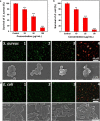Bactericidal effects and accelerated wound healing using Tb4O7 nanoparticles with intrinsic oxidase-like activity
- PMID: 30992018
- PMCID: PMC6466657
- DOI: 10.1186/s12951-019-0487-x
Bactericidal effects and accelerated wound healing using Tb4O7 nanoparticles with intrinsic oxidase-like activity
Abstract
Background: Nanomaterials that exhibit intrinsic enzyme-like characteristics have shown great promise as potential antibacterial agents. However, many of them exhibit inefficient antibacterial activity and biosafety problems that limit their usefulness. The development of new nanomaterials with good biocompatibility and rapid bactericidal effects is therefore highly desirable. Here, we show a new type of terbium oxide nanoparticles (Tb4O7 NPs) with intrinsic oxidase-like activity for in vitro and in vivo antibacterial application.
Results: We find that Tb4O7 NPs can quickly oxidize a series of organic substrates in the absence of hydrogen peroxide. The oxidase-like capacity of Tb4O7 NPs allows these NPs to consume antioxidant biomolecules and generate reactive oxygen species to disable bacteria in vitro. Moreover, the in vivo experiments showed that Tb4O7 NPs are efficacious in wound-healing and are protective of normal tissues.
Conclusions: Our results reveal that Tb4O7 NPs have intrinsic oxidase-like activity and show effective antibacterial ability both in vitro and in vivo. These findings demonstrate that Tb4O7 NPs are effective antibacterial agents and may have a potential application in wound healing.
Keywords: Antibacterial; Oxidase; Reactive oxygen species; Tb4O7 nanoparticles; Wound healing.
Conflict of interest statement
The authors declare that they have no competing interests.
Figures







Similar articles
-
Bienzymatic synergism of vanadium oxide nanodots to efficiently eradicate drug-resistant bacteria during wound healing in vivo.J Colloid Interface Sci. 2020 Feb 1;559:313-323. doi: 10.1016/j.jcis.2019.09.040. Epub 2019 Sep 12. J Colloid Interface Sci. 2020. PMID: 31675662
-
Antibacterial Photodynamic Gold Nanoparticles for Skin Infection.ACS Appl Bio Mater. 2021 Apr 19;4(4):3124-3132. doi: 10.1021/acsabm.0c01505. Epub 2021 Mar 19. ACS Appl Bio Mater. 2021. PMID: 35014400
-
Near-Infrared Light-Controllable Multifunction Mesoporous Polydopamine Nanocomposites for Promoting Infected Wound Healing.ACS Appl Mater Interfaces. 2022 Jan 19;14(2):2534-2550. doi: 10.1021/acsami.1c19209. Epub 2022 Jan 5. ACS Appl Mater Interfaces. 2022. PMID: 34985258
-
Antibacterial activities of transient metals nanoparticles and membranous mechanisms of action.World J Microbiol Biotechnol. 2019 Oct 14;35(10):162. doi: 10.1007/s11274-019-2742-6. World J Microbiol Biotechnol. 2019. PMID: 31612285 Review.
-
Potential Biomedical Applications of Terbium-Based Nanoparticles (TbNPs): A Review on Recent Advancement.ACS Biomater Sci Eng. 2024 May 13;10(5):2703-2724. doi: 10.1021/acsbiomaterials.3c01969. Epub 2024 Apr 22. ACS Biomater Sci Eng. 2024. PMID: 38644798 Review.
Cited by
-
Metal-organic framework-modulated Fe3O4 composite au nanoparticles for antibacterial wound healing via synergistic peroxidase-like nanozymatic catalysis.J Nanobiotechnology. 2023 Nov 15;21(1):427. doi: 10.1186/s12951-023-02186-6. J Nanobiotechnology. 2023. PMID: 37968680 Free PMC article.
-
Bioactive inorganic particles-based biomaterials for skin tissue engineering.Exploration (Beijing). 2022 Mar 17;2(5):20210083. doi: 10.1002/EXP.20210083. eCollection 2022 Oct. Exploration (Beijing). 2022. PMID: 37325498 Free PMC article. Review.
-
A Review on Metal- and Metal Oxide-Based Nanozymes: Properties, Mechanisms, and Applications.Nanomicro Lett. 2021 Jul 9;13(1):154. doi: 10.1007/s40820-021-00674-8. Nanomicro Lett. 2021. PMID: 34241715 Free PMC article. Review.
-
Research progress of chilled meat freshness detection based on nanozyme sensing systems.Food Chem X. 2024 Apr 8;22:101364. doi: 10.1016/j.fochx.2024.101364. eCollection 2024 Jun 30. Food Chem X. 2024. PMID: 38623515 Free PMC article. Review.
-
The In Vivo, In Vitro and In Ovo Evaluation of Quantum Dots in Wound Healing: A Review.Polymers (Basel). 2021 Jan 7;13(2):191. doi: 10.3390/polym13020191. Polymers (Basel). 2021. PMID: 33430272 Free PMC article. Review.
References
MeSH terms
Substances
Grants and funding
LinkOut - more resources
Full Text Sources
Medical

